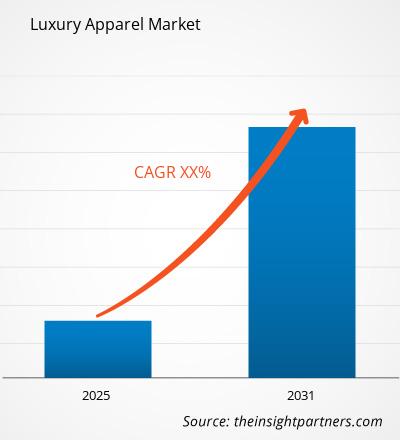MARKET INTRODUCTION
Luxury clothing or apparel is typically thought of as a status symbol for people with high income and have high discretionary spending power. These are branded clothes made of purest fabrics. The finest quality fabric used for making luxury apparel offers a better clothing experience than general clothes. Luxury apparel make people stand out from the crowd. They help boost self-esteem. They are produced in a smaller number and hence, they are unique in style and design. Luxury apparel brands are known for their consistency in product quality and for paying close attention to customer feedback.
MARKET DYNAMICS
Product demand is being driven by a growing assumption among customers that luxury products lead to higher social acceptance. Demand is also being driven by rising disposable income and consumer expenditure on high-end premium goods. Luxury apparels have a greater price range and style quotient, however one of the primary restrictions for the luxury apparel market is the easy availability of counterfeit products of leading brands at lower rates. Consumers' inadequate knowledge about the authenticity of these products causes them to purchase counterfeit goods, harming their brand loyalty.
MARKET SCOPE
The "Global Luxury Apparel Market Analysis to 2031" is a specialized and in-depth study of the consumer goods industry with a particular focus on the global market trend analysis. The report aims to provide an overview of the luxury apparel market with detailed market segmentation based on type, end user, and distribution channel. The global luxury apparel market is expected to witness high growth during the forecast period. The report provides key statistics on the market status of the leading luxury apparel market players and offers key trends and opportunities in the market.
MARKET SEGMENTATION
The global luxury apparel market is segmented into type, end user, and distribution channel. By type the luxury apparel market is segmented into jackets & coats, skirts, shirts & t-shirts, dresses, trousers & shorts, and others. By end user the luxury apparel market is segmented into women, men, and unisex. By distribution channel, the luxury apparel market is classified into supermarkets and hypermarkets, specialty stores, online retail, and others.
REGIONAL FRAMEWORK
The report provides a detailed overview of the industry, including both qualitative and quantitative information. It provides an overview and forecast of the global luxury apparel market based on various segments. It also provides market size and forecast estimates from the year 2021 to 2031 concerning five major regions, namely; North America, Europe, Asia-Pacific (APAC), Middle East and Africa (MEA), and South America. The luxury apparel market by each region is later sub-segmented by respective countries and segments. The report covers the analysis and forecast of 18 countries globally, along with the current trend and opportunities prevailing in the region.
The report analyzes factors affecting the luxury apparel market from both demand and supply side. Further, it evaluates market dynamics affecting the market during the forecast period, i.e., drivers, restraints, opportunities, and future trends. The report also provides exhaustive PEST analysis for all five regions, namely; North America, Europe, APAC, MEA, and South America, after evaluating political, economic, social, and technological factors affecting the luxury apparel in these regions.
MARKET PLAYERS
The report covers vital developments in the luxury apparel as organic and inorganic growth strategies. Various companies are focusing on organic growth strategies such as product launches, product approvals, and others, such as patents and events. Inorganic growth strategies activities witnessed in the market were acquisitions and partnerships & collaborations. These activities have paved the way for the expansion of business and customer base of market players. The market payers from the luxury apparel are anticipated to lucrative growth opportunities in the future with the rising demand for luxury apparel in the global market. Below mentioned is the list of few companies engaged in the luxury apparel market.
The report also includes the profiles of key companies along with their SWOT analysis and market strategies in the luxury apparel market. Besides, the report focuses on leading industry players with information such as company profiles, components, and services offered, financial information of the last three years, the critical development in the past five years.
- PRADA
- Giorgio Armani S.p.A
- LVMH
- Dolce and Gabbana
- Burberry Group PLC
- Gianni Versace S.r.l.
- CHANEL
- Hermès
- Valentino S.p.A
- Balenciaga
Luxury Apparel Report Scope
| Report Attribute | Details |
|---|---|
| Market size in 2024 | US$ XX million |
| Market Size by 2031 | US$ XX Million |
| Global CAGR (2025 - 2031) | XX% |
| Historical Data | 2021-2023 |
| Forecast period | 2025-2031 |
| Segments Covered |
By Type
|
| Regions and Countries Covered | North America
|
| Market leaders and key company profiles |
- Historical Analysis (2 Years), Base Year, Forecast (7 Years) with CAGR
- PEST and SWOT Analysis
- Market Size Value / Volume - Global, Regional, Country
- Industry and Competitive Landscape
- Excel Dataset



Report Coverage
Revenue forecast, Company Analysis, Industry landscape, Growth factors, and Trends

Segment Covered
This text is related
to segments covered.

Regional Scope
North America, Europe, Asia Pacific, Middle East & Africa, South & Central America

Country Scope
This text is related
to country scope.
Trends and growth analysis reports related to Consumer Goods : READ MORE..
The List of Companies
1. PRADA
2. Giorgio Armani S.p.A
3. LVMH
4. Dolce and Gabbana
5. Burberry Group PLC
6. Gianni Versace S.r.l.
7. CHANEL
8. Hermès
9. Valentino S.p.A
10. Balenciaga
1. PRADA
2. Giorgio Armani S.p.A
3. LVMH
4. Dolce and Gabbana
5. Burberry Group PLC
6. Gianni Versace S.r.l.
7. CHANEL
8. Hermès
9. Valentino S.p.A
10. Balenciaga

 Get Free Sample For
Get Free Sample For